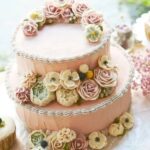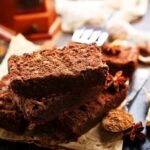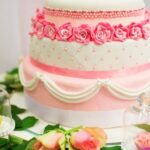When it comes to cake decoration, the possibilities are endless. From intricate piping designs to fondant sculptures, bakers around the world continue to push the boundaries of creativity with their edible works of art.
One trend that has been gaining popularity in recent years is decorating cakes with real flowers. The use of beautiful blooms not only adds a touch of elegance and sophistication to a cake but also allows for a seamless integration of nature’s beauty into the world of baking.
The aesthetic appeal of using real flowers on cakes cannot be overstated. The delicate petals, vibrant colors, and natural forms create visually stunning and Instagram-worthy desserts. Moreover, flowers can effortlessly complement any theme or style, whether it’s a rustic wedding cake adorned with wildflowers or a modern birthday cake embellished with sleek blooms.
However, the benefits go beyond aesthetics. Real flowers bring a certain freshness and organic charm that artificial alternatives cannot replicate. Natural elements have been known to enhance the overall design by creating depth, texture, and a sense of whimsy. So if you’re looking to create a show-stopping cake that is both beautiful and innovative, decorating it with real flowers might just be the answer you’ve been searching for.
The Dos and Don’ts of Choosing Suitable Flowers for Cake Decoration
Choosing suitable flowers for cake decoration is an important aspect of creating a beautiful and safe final product. When selecting flowers to adorn a cake, there are certain dos and don’ts that need to be considered to ensure both the aesthetic appeal and food safety.
First and foremost, it is crucial to choose non-toxic flowers that are safe for consumption. Not all flowers are edible, and some can even be toxic if ingested. It is recommended to consult reliable sources or floral experts to determine which flowers are safe for use on cakes. Common edible flowers include roses, violets, lavender, marigolds, pansies, and chamomile. These flowers not only add visual beauty but also impart delicate flavors that complement the cake.
When picking flowers for cake decoration, it’s essential to consider the flavors and design of the cake. Opt for flowers that enhance the overall aesthetics and do not overpower the taste of the cake.
For instance, if you’re working with a citrus-flavored cake, choose bright-colored flowers like marigolds or calendulas that complement those flavors. On the other hand, if you have a rich chocolate cake, consider using deep-colored blossoms such as deep red roses or purple pansies.
Additionally, ensure that the chosen flowers have not been exposed to chemicals or pesticides that may pose health risks when consumed. Always select organic or locally sourced flowers whenever possible to minimize exposure to harmful substances. It’s also advisable to ask your florist or flower provider about their growing practices before purchasing any blooms for cake decoration.
By following these dos and don’ts of choosing suitable flowers for decorating cakes, you can create visually stunning creations while ensuring they remain safe for consumption. The right selection of edible flowers can elevate your cake design by adding both beauty and subtle flavors that will leave your guests impressed with your creativity in incorporating natural elements into your baking artistry.
How to Properly Clean and Prepare Flowers for Cake Decoration
Decorating cakes with real flowers can create a stunning and natural aesthetic that adds a touch of elegance to any celebration. However, before incorporating flowers into cake decoration, it is essential to properly clean and prepare them to ensure food safety. This section will provide a step-by-step guide on how to clean flowers for cake decoration and techniques for removing potentially harmful elements.
When it comes to using flowers for cake decoration, it is crucial to select non-toxic flowers that are safe for consumption. Start by choosing fresh flowers that are free from pesticides or other chemicals. It is recommended to use organic or edible flowers specifically grown for culinary purposes. Avoid picking flowers from the roadside or areas where they may have come into contact with pollutants.
Cleaning the flowers is an important step to remove any dirt, pests, or residual pesticides. Fill a bowl with cool water and gently submerge the flowers, being careful not to damage their petals. Gently swish the water around to dislodge any dirt or insects. If there are visible pests on the flowers, you can invert them under running water or gently shake them outdoors.
| Steps | Description |
|---|---|
| Step 1 | Select fresh and non-toxic flowers suitable for cake decoration. |
| Step 2 | Fill a bowl with cool water and gently submerge the flowers. |
| Step 3 | Swish the water around gently to remove dirt and insects. |
After cleaning the flowers, it is important to remove potentially harmful elements such as pollen. Pollen can cause allergies in some individuals and can also contaminate the cake. To remove the pollen, carefully pluck off the stamens from the flowers using clean and sanitized hands or tweezers. By removing the stamens, you eliminate any risk of pollen transfer onto the cake.
It is crucial to handle flowers with care and maintain hygiene throughout the cleaning process. Wash your hands thoroughly before and after handling the flowers, ensuring that no harmful bacteria are transferred to the cake. Following these steps will help ensure that your cake decoration with real flowers is not only visually appealing but also safe for consumption.
Methods for Securing Flowers to a Cake
When it comes to decorating cakes with real flowers, it is essential to ensure that they are securely attached without causing any damage or contamination. There are various techniques and tools available that can help achieve this, allowing you to create stunning floral arrangements on your cake. Here are some methods for securing flowers to a cake:
- Floral Picks or Skewers: Floral picks or skewers are commonly used to attach flowers to cakes. For this method, carefully insert the pointed end of the pick or skewer into the stem of the flower, making sure it goes through the base and out of the other side. Then, gently push the pick or skewer into the cake at the desired position.
- Flower Tubes: Flower tubes are small plastic containers with a cap at one end and multiple holes on the other end. Fill the tube with water and place individual flowers into each hole, ensuring that the stems sit in water and remain hydrated. Insert the flower tube into the cake by gently pushing it downward at an angle.
- Floral Wire: To use floral wire for attaching flowers to a cake, select flowers with sturdy stems. Wrap floral wire around each stem tightly but carefully, taking care not to damage delicate petals or leaves. Leave a small length of wire extending from each stem and insert it into the cake until secure.
When arranging flowers on a cake, consider their size and weight distribution to create visually appealing designs that enhance the overall aesthetic. Start by placing larger focal flowers strategically around the cake before filling in gaps with smaller blooms, foliage, or filler flowers like baby’s breath.
Remember that when using real flowers on cakes, it is crucial to ensure food safety and prevent any toxic elements from coming into contact with edible portions of the cake. Therefore, always take precautions such as using non-toxic organic flowers sourced from reliable suppliers and washing them properly before use.
Taking proper care when securing flowers to a cake and arranging them thoughtfully will result in a visually stunning masterpiece that combines the beauty of nature with the art of baking. With these methods, you can confidently decorate cakes with real flowers and create designs that leave a lasting impression.
Important Considerations
Decorating cakes with real flowers can add a touch of natural beauty and elegance, but it is crucial to prioritize food safety when incorporating these floral elements. While many flowers are safe for consumption, there are potential risks associated with using real flowers on cakes. It is essential to ensure that the flowers are free from harmful chemicals or toxins that could contaminate the cake.
When using real flowers for cake decoration, it is important to source the flowers from reputable suppliers that specifically grow edible flowers without using pesticides or other chemical treatments. This ensures that the flowers are safe for consumption and won’t pose any health risks to those enjoying the cake. It’s also advisable to discuss any food allergies or sensitivities with clients before incorporating real flowers into their cake design.
To further enhance food safety, it is recommended to clean and prepare the flowers properly before applying them to the cake. This includes removing any dirt or pests by gently rinsing the flowers under cool water and allowing them to air dry. It’s also important to remove potentially harmful elements such as pollen, which can cause allergic reactions in some individuals.
Flower selection plays a key role in ensuring food safety as well. Opt for organic edible flowers that are widely recognized as safe for consumption, such as roses, pansies, marigolds, violets, lavender, and daisies. Avoid using highly toxic or poisonous flowers like lilies of the valley or foxgloves. Additionally, it’s crucial not to consume any flower decorations if you are unsure about their origin or if they have been treated with any non-edible substances.
Ensuring food safety should always be a priority when using real flowers on cakes. By carefully selecting safe and organic edible flowers while taking necessary precautions during cleaning and preparation processes, bakers can create stunning cake designs without compromising anyone’s health or well-being.
| Consideration | Guidelines |
|---|---|
| Source of flowers | Reputable suppliers that grow edible flowers without pesticides or chemical treatments |
| Allergies and sensitivities | Discuss with clients before incorporating real flowers into the cake design |
| Cleaning and preparation | Rinse flowers under cool water to remove dirt and pests, remove pollen, and allow them to air dry |
| Selection of safe flowers | Choose organic edible flowers recognized as safe for consumption. Avoid highly toxic or poisonous flowers. |
Alternative Use of Real Flowers
Real flowers not only add a visual appeal to cakes, but they can also infuse unique flavors and enhance the overall taste of the dessert. This alternative use of real flowers has gained popularity among bakers looking to experiment with their cake designs and surprise their taste buds. In this section, we will explore how edible flowers can be incorporated into different aspects of cake making, from the batter to the frosting.
Exploring Edible Flowers
Edible flowers are varieties that are safe for consumption and often used in cooking or garnishing dishes. However, not all flowers are suitable for eating, so it is essential to do thorough research or consult an expert before using them in your cake recipes. Some common edible flower options include roses, lavender, violets, marigolds, and pansies. Each flower offers its own distinct flavor profile and can complement various cake flavors.
Incorporating Flowers into Cake Batters
One way to utilize real flowers is by incorporating them directly into the cake batter. The petals or even whole flowers can be finely chopped and added to the dry ingredients before mixing them with wet ingredients. This allows the flavors of the flowers to infuse into the cake as it bakes. For example, rose petals can impart a delicate floral taste, while lavender can add a subtle herbal note.
Enhancing Frostings and Garnishes
Another way to incorporate real flowers is by incorporating them in frostings or as decorative garnishes on top of cakes. Dried flowers like chamomile or calendula can be ground into powder form and added to frosting recipes for an extra dimension of flavor. Fresh flower petals can also be used as a beautiful garnish on top of frosted cakes, adding both color and taste.
Overall, experimenting with edible flowers opens up a world of possibilities for decorating cakes while adding unique flavors. It is important to ensure that the flowers used are safe for consumption and free from any harmful chemicals or pesticides. By embracing the beauty of nature and infusing it into cake decoration, bakers can create stunning and delicious creations that are sure to impress both visually and gustatorily.
Showcasing Inspirational Cake Designs with Real Flowers
Decorating cakes with real flowers offers a unique and visually stunning way to elevate the aesthetics of any cake design. The use of real flowers in cake decoration has become increasingly popular, as it adds a touch of natural beauty and elegance to the dessert. In this section, we will showcase a selection of inspirational cake designs that successfully incorporate real flowers.
To inspire your own creations, here are some stunning examples of how different flower types and arrangements can create various moods and styles:
- Rustic Elegance: A simple yet charming cake adorned with delicate wildflowers like daisies or lavender sprigs creates an effortlessly rustic look, perfect for outdoor weddings or garden-themed celebrations.
- Whimsical Delight: For a whimsical and fairy-tale-like design, consider using larger blooms such as peonies or roses in vibrant colors. Arrange them cascading down the sides of the cake for a romantic, dreamy effect.
- Modern Minimalism: Minimalist cake designs are on-trend right now, and real flowers can add just the right touch of natural beauty to these sleek creations. Opt for monochromatic color schemes and minimalist flower arrangements using elegant blooms like orchids or tulips.
- Bohemian Chic: Create a boho-inspired cake by incorporating wildflowers like sunflowers or daisies along with greenery such as eucalyptus leaves or ferns. Add pops of color with small blossoms like pansies or violas for a fun, carefree vibe.
Remember that when using real flowers on cakes, it is important to ensure they are properly cleaned and prepared before decorating. Additionally, make sure the flowers are free from harmful chemicals or toxins to ensure food safety.
These inspirational designs demonstrate the versatility and beauty that can be achieved when decorating cakes with real flowers. By incorporating live blooms into your designs, you can create truly show-stopping cakes that will leave a lasting impression on guests.
Expert Insights
Importance of Expert Insights in Cake Decoration
When it comes to any creative endeavor, gaining insights from experts can be invaluable. In the world of cake decoration, professional cake decorators provide a wealth of knowledge and experience that can help aspiring bakers elevate their skills. In this section, we will delve into the expert insights from renowned cake decorators who have successfully incorporated real flowers into their designs.
Discovering Favorite Flowers for Cake Decoration
Every cake decorator has their own preferences and favorite flowers to work with. Some find delight in using delicate roses to create a romantic atmosphere on their cakes, while others may gravitate towards vibrant sunflowers for a cheerful and rustic look. Through interviews with professional cake decorators, readers will gain insights into the flower choices these experts favor.
The interviews will also explore how the professionals make decisions about which flowers to use based on factors such as color coordination, the symbolism of specific flowers in different cultures, and personal style preferences. By understanding their thought process and experienced opinions, aspiring cake decorators can expand their knowledge and inspiration when working with real flowers.
Perspectives on the Growing Popularity of Decorating Cakes with Real Flowers
As the trend of decorating cakes with real flowers continues to gain popularity, it is valuable to hear directly from experts about their thoughts on this phenomenon. The interviews will touch upon topics such as the benefits and challenges they have encountered when working with real flowers.
Professional cake decorators will also share any precautions they take or innovations they have developed to ensure that cakes decorated with real flowers remain safe for consumption. Their insight into both the opportunities and potential pitfalls can serve as a guide for those looking to venture into this creative realm.
Addressing Common Concerns and FAQs Regarding Decorating Cakes with Real Flowers
Decorating cakes with real flowers has become a popular trend in the baking world, adding a touch of natural beauty and versatility to cake designs. However, many people have concerns and questions about using real flowers for cake decoration. In this section, we will address some common concerns and provide well-researched answers to frequently asked questions.
One common concern is the safety of using real flowers on cakes. It is important to ensure that the flowers chosen for decoration are non-toxic and safe for consumption. Some flowers are not suitable for decorating cakes because they may contain harmful chemicals or toxins. When selecting flowers, it is crucial to do thorough research or consult with a florist to identify which ones are safe to use.
Another frequently asked question is how long the flowers will last on a cake. While some flowers may wilt over time, proper care can help them stay fresh longer. For example, refrigerating the cake can help extend the lifespan of the flowers. However, it is best to arrange the flowers on the cake as close to serving time as possible to maintain their freshness and avoid wilting.
Many individuals also wonder about practicality when it comes to decorating cakes with real flowers. One common concern is whether the moisture from frosting or condensation from refrigeration will affect the appearance or taste of the flowers. To overcome this issue, it is recommended to use a barrier between the cake and floral decorations, such as wax paper or parchment paper, to prevent direct contact.
By addressing these concerns and answering these FAQs, we hope to alleviate any hesitations people may have about using real flowers for cake decoration. With proper precautions and knowledge, incorporating real flowers into cake designs can elevate their aesthetic appeal while ensuring food safety and creating a delightful sensory experience for both visual and gustatory pleasure.
Conclusion
In conclusion, decorating cakes with real flowers offers a unique and visually stunning way to enhance the beauty of cake designs. This trend has gained popularity in the baking world due to its ability to bring a touch of nature and elegance to any occasion. By carefully selecting suitable flowers and following proper cleaning and preparation techniques, it is possible to create beautiful cake decorations that are safe for consumption.
When choosing flowers for cake decoration, it is essential to prioritize non-toxic varieties and consider how they will complement the flavors and overall design of the cake. By selecting flowers that harmonize with the taste profile and aesthetics, you can elevate the visual appeal of your creation. Additionally, proper cleaning methods help remove dirt, pests, pesticides, or pollen from the flowers before they come into contact with the cake.
Securing flowers to a cake requires special consideration to avoid causing damage or contamination. Fortunately, there are various techniques and tools available that can safely attach flowers without compromising food safety. It is important to arrange the flowers in a visually appealing manner that enhances the overall cake design while also ensuring that they do not come into direct contact with frosting or other edible elements.
Overall, by embracing the beauty of nature in cake decoration with real flowers, you can add a touch of elegance and creativity to your creations. Whether it’s through infusing unique flavors or enhancing aesthetics, using real flowers on cakes opens up endless possibilities for experimentation and innovation. So why not unleash your creativity today and explore this growing trend in cake decoration? Embrace the beauty of nature and take your cakes to new heights.
Frequently Asked Questions
Is it safe to decorate a cake with fresh flowers?
Decorating a cake with fresh flowers can be safe, as long as certain precautions are taken. Firstly, it is crucial to ensure that the flowers used are organic and free from pesticides or other harmful chemicals. It is advisable to source the flowers from a reputable floral supplier or ensure they come from a safe garden where no chemical treatments have been applied. Secondly, the flowers should be thoroughly cleaned and washed before being placed on the cake to remove any dirt or potential allergens.
To prevent direct contact between the flowers and the cake’s surface, it is best to use small pieces of parchment paper or food-safe plastic wrap as a barrier. This will prevent any potential transfer of substances onto the cake. Lastly, it’s important to remember that while some flowers are safe for decoration purposes, they still shouldn’t be consumed due to their natural toxicity.
What real flowers are safe to put on a cake?
When choosing real flowers for decorating a cake, it is essential to select varieties that are known to be safe for consumption and have not been treated with any chemicals. Some popular options include roses, pansies, violets, marigolds (calendula), lavender, chamomile, borage, and daisies.
These flowers are generally considered safe and add an elegant touch to cakes when used appropriately. However, it is important to double-check each specific flower variety individually for edibility and safety before using them on a cake.
How do you decorate a cake with natural flowers?
Decorating a cake with natural flowers requires careful consideration of preparation and placement techniques. Firstly, once you have chosen the appropriate edible flowers, gently wash them under cold water to remove any traces of dirt or insects carefully. Pat them dry using paper towels and allow them to air-dry fully before placing them on the cake. If desired petal placements are predetermined in a design plan or sketch, snip off individual petals or remove blooms from stems accordingly using clean scissors or shears directly over the cake surface before discard leftover parts.
To ensure proper hygiene, apply a thin layer of buttercream or frosting on the cake’s surface and then proceed to arrange the flowers as desired. Avoid inserting flower stems directly into the cake since this may introduce non-edible components into it. Instead, place each flower delicately on the frosting or buttercream, ensuring it makes minimal contact with the actual cake. Remember to inform guests that the flowers are for decorative purposes only and should not be consumed.

Welcome to my blog about home and family. This blog is a place where I will share my thoughts, ideas, and experiences related to these important topics. I am a stay-at-home mom with two young children. I hope you enjoy reading it! and may find some helpful tips and ideas that will make your home and family life even better!





